#Camille Léon
Text

Black punk revolution || A song I wrote & composed
#black punk#black alternative#aphrodite#me#blackout#black model#indie rock#rock#jackson guitars#camille léon#grunge#glitter grunge#black grunge#tina bell#willow smith#rico nasty#fefe dobson
315 notes
·
View notes
Photo

Burial of Life As a Young Girl (Des jeunes filles enterrent leur vie), Maïté Sonnet (2022)
#Maïté Sonnet#Luna Carpiaux#Aloïse Sauvage#Natacha Krief#Camille Léon Fucien#Salomé Partouche#Marine Atlan#Pierre Desprats#Marylou Vergez#2022#woman director
21 notes
·
View notes
Photo







Dangerous Liaisons (2022)
... in the end
#dangerous liaisons#netflix#france#movie#ya#entertainment#biarritz#celene riva#tristan badiola#tristan x celene#paola locatelli#simon rérolle#héloïse janjaud#jin xuan mao#oscar lesage#Elsa Duchez Paverani#camille léon-fucien#alexis michalik#romance#cruel intentions#diversity#black women#bw#beach wedding#beach#love is love#throuple#dangerous liaisons 2022
14 notes
·
View notes
Text
Paris, 13th District
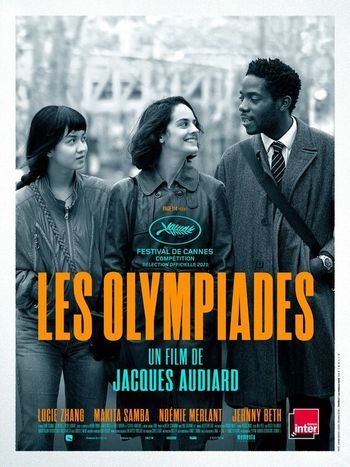
Paris, 13th District [trailer]
Émilie meets Camille who is attracted to Nora, who crosses paths with Amber. Three girls and a boy - They're friends, sometimes lovers and often both.
As they say, relationships, it's complicated. In this case, in a good and interesting way.
I can understand that Camille was at times a bit confused by Émilie. She's a demanding character.
#Paris 13th District#Les Olympiades#Jacques Audiard#Lucie Zhang#Makita Samba#Noémie Merlant#Jehnny Beth#Camille Léon Fucien#Oceane Cairaty#foreign#France#like#recommended#black and white
2 notes
·
View notes
Text
Drone Games
Drone Games (2023)
#OlivierAbbou #AliceBelaidi #AxelGranberger #AngeleMetzger #CamilleLeonFucien #OrlandoVauthier
Mehr auf:
Jahr: 2023 (Oktober)
Genre: Action / Krimi
Regie: Olivier Abbou
Hauptrollen: Alice Belaïdi, Axel Granberger, Angèle Metzger, Camille Léon-Fucien, Orlando Vauthier, Maxime Thébault …
Filmbeschreibung: Eine Gruppe von Dieben verstrickt sich mit einem einsamen Teenager, einem Drohnenliebhaber, und zieht ihn in eine Serie von Raubüberfällen…

View On WordPress
0 notes
Text
La Normandie et les peintres 2
La Normandie et les peintres 2

View On WordPress
#Abraham Storck#Alliance Franco-russe#Ambroise Louis Garneray#Antoine Chazal#Antoine-Léon Morel-Fatio#Armand-Auguste Fréret#Camille Flers#Cherbourg#Félix Buhot#Guillaume Fouace#Herman Melville#Jean-Louis Demarne#Jean-Louis Petit#Jules Héreau#Léon-Gustave Ravanne#Louis-Napoléon#Moby Dick#Musée Thomas Henry#Nicolas II#Paul Gallard-Lépinay#Philippe-Auguste Jeanron#Théodore Deligny
1 note
·
View note
Text

Léon Cogniet (1794-1880)
"Métabus et Camille"
In Virgil's Aeneid, Camilla is the daughter of King Metabus and Casmilla.
Driven from his throne, Metabus is chased into the wilderness by armed Volsci, his infant daughter in his hands. The river Amasenus blocked his path, and, fearing for his child's welfare, Metabus bound her to a spear. He promised Diana that Camilla would be her servant, a warrior virgin. He then safely threw her to the other side, and swam across to retrieve her. The baby Camilla was suckled by a mare, and once her "first firm steps had [been] taken, the small palms were armed with a keen javelin; her sire a bow and quiver from her shoulder slung." She was raised in her childhood to be a huntress and kept the companionship of her father and the shepherds in the hills and woods.
#paintings#art#artwork#mythological painting#roman mythology#léon cogniet#leon cogniet#fine art#french artist#king metabus#camilla#diana#history#folklore#virgil's aeneid#male figure#father and child#father and daughter#protective#protect#fatherly love#family#baby#infant#children#babies#1800s#19th century#aesthetic#aesthetics
250 notes
·
View notes
Text
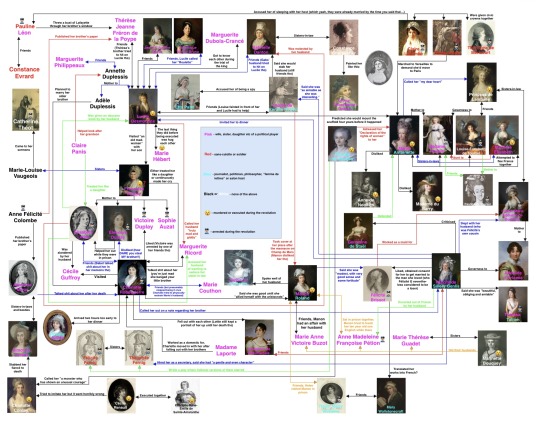
I decided to try this but for the girlies instead.
Are you sure want to click on ”keep reading”?
For Pauline Léon marrying Claire Lacombe’s host, see Liberty: the lives of six women in Revolutionary France (2006) by Lucy Moore, page 230
For Pauline Léon throwing a bust of Lafayette through Fréron’s window and being friends with Constance Evrard, see Pauline Léon, une républicaine révolutionnaire (2006) by Claude Guillon.
For Françoise Duplay’s sister visiting Catherine Théot, see Points de vue sur l’affaire Catherine Théot (1969) by Michel Eude, page 627.
For Anne Félicité Colombe publishing the papers of Marat and Fréron, see The women of Paris and their French Revolution (1998) by Dominique Godineau, page 382-383.
For the relationship between Simonne Evrard and Albertine Marat, see this post.
For Albertine Marat dissing Charlotte Robespierre, see F.V Raspail chez Albertine Marat (1911) by Albert Mathiez, page 663.
For Lucile Desmoulins predicting Marie-Antoinette would mount the scaffold, see the former’s diary from 1789.
For Lucile being friends with madame Boyer, Brune, Dubois-Crancé, Robert and Danton, calling madame Ricord’s husband ”brusque, coarse, truly mad, giddy, insane,” visiting ”an old madwoman” with madame Duplay’s son and being hit on by Danton as well as Louise Robert saying she would stab Danton, see Lucile’s diary 1792-1793.
For the relationship between Lucile Desmoulins and Marie Hébert, see this post.
For the relationship between Lucile Desmoulins and Thérèse Jeanne Fréron de la Poype, and the one between Annette Duplessis and Marguerite Philippeaux, see letters cited in Camille Desmoulins and his wife: passages from the history of the dantonists (1876) page 463-464 and 464-469.
For Adèle Duplessis having been engaged to Robespierre, see this letter from Annette Duplessis to Robespierre, seemingly written April 13 1794.
For Claire Panis helping look after Horace Desmoulins, see Panis précepteur d’Horace Desmoulins (1912) by Charles Valley.
For Élisabeth Lebas being slandered by Guffroy, molested by Danton, treated like a daughter by Claire Panis, accusing Ricord of seducing her sister-in-law and being helped out in prison by Éléonore, see Le conventionnel Le Bas : d'après des documents inédits et les mémoires de sa veuve, page 108, 125-126, 139 and 140-142.
For Élisabeth Lebas being given an obscene book by Desmoulins, see this post.
For Charlotte Robespierre dissing Joséphine, Éléonore Duplay, madame Genlis, Roland and Ricord, see Mémoires de Charlotte Robespierre sur ses deux frères (1834), page 76-77, 90-91, 96-97, 109-116 and 128-129.
For Charlotte Robespierre arriving two hours early to Rosalie Jullien’s dinner, see Journal d’une Bourgeoise pendant la Révolution 1791–1793, page 345.
For Charlotte Robespierre and Françoise Duplay’s relationship, see Mémoires de Charlotte Robespierre sur ses deux frères (1834) page 85-92 and Le conventional Le Bas: d’après des documents inédits et les mémoires de sa veuve (1902) page 104-105
For the relationship between Charlotte Robespierre and Victoire and Élisabeth Lebas, see this post.
For Charlotte Robespierre visiting madame Guffroy, moving in with madame Laporte and Victoire Duplay being arrested by one of Charlotte’s friends, see Charlotte Robespierre et ses amis (1961)
For Louise de Kéralio calling Etta Palm a spy, see Appel aux Françoises sur la régénération des mœurs et nécessité de l’influence des femmes dans un gouvernement libre (1791) by the latter.
For the relationship between Manon Roland and Louise de Kéralio Robert, see Mémoires de Madame Roland, volume 2, page 198-207
For the relationship between Madame Pétion and Manon Roland, see Mémoires de Madame Roland, volume 2, page 158 and 244-245 as well as Lettres de Madame Roland, volume 2, page 510.
For the relationship between Madame Roland and Madame Buzot, see Mémoires de Madame Roland (1793), volume 1, page 372, volume 2, page 167 as well as this letter from Manon to her husband dated September 9 1791. For the affair between Manon and Buzot, see this post.
For Manon Roland praising Condorcet, see Mémoires de Madame Roland, volume 2, page 14-15.
For the relationship between Manon Roland and Félicité Brissot, see Mémoires de Madame Roland, volume 1, page 360.
For the relationship between Helen Maria Williams and Manon Roland, see Memoirs of the Reign of Robespierre (1795), written by the former.
For the relationship between Mary Wollstonecraft and Helena Maria Williams, see Collected letters of Mary Wollstonecraft (1979), page 226.
For Constance Charpentier painting a portrait of Louise Sébastienne Danton, see Constance Charpentier: Peintre (1767-1849), page 74.
For Olympe de Gouges writing a play with fictional versions of the Fernig sisters, see L’Entrée de Dumourier à Bruxelles ou les Vivandiers (1793) page 94-97 and 105-110.
For Olympe de Gouges calling Charlotte Corday ”a monster who has shown an unusual courage,” see a letter from the former dated July 20 1793, cited on page 204 of Marie-Olympe de Gouges: une humaniste à la fin du XVIIIe siècle (2003) by Oliver Blanc.
For Olympe de Gouges adressing her declaration to Marie-Antoinette, see Les droits de la femme: à la reine (1791) written by the former.
For Germaine de Staël defending Marie-Antoinette, see Réflexions sur le procès de la Reine par une femme (1793) by the former.
For the friendship between Madame Royale and Pauline Tourzel, see Souvernirs de quarante ans: 1789-1830: récit d’une dame de Madame la Dauphine (1861) by the latter.
For Félicité Brissot possibly translating Mary Wollstonecraft, see Who translated into French and annotated Mary Wollstonecraft’s Vindication of the Rights of Woman? (2022) by Isabelle Bour.
For Félicité Brissot working as a maid for Louise Marie Adélaïde de Bourbon, see Mémoires inédites de Madame la comptesse de Genlis: sur le dix-huitième siècle et sur la révolution française, volume 4, page 106.
For Reine Audu, Claire Lacombe and Théroigne de Méricourt being given civic crowns together, see Gazette nationale ou le Moniteur universel, September 3, 1792.
For Reine Audu taking part in the women’s march on Versailles, see Reine Audu: les légendes des journées d’octobre (1917) by Marc de Villiers.
For Marie-Antoinette calling Lamballe ”my dear heart,” see Correspondance inédite de Marie Antoinette, page 197, 209 and 252.
For Marie-Antoinette disliking Madame du Barry, see https://plume-dhistoire.fr/marie-antoinette-contre-la-du-barry/
For Marie-Antoinette disliking Anne de Noailles, see Correspondance inédite de Marie Antoinette, page 30.
For Louise-Élisabeth Tourzel and Lamballe being friends, see Memoirs of the Duchess de Tourzel: Governess to the Children of France during the years 1789, 1790, 1791, 1792, 1793 and 1795 volume 2, page 257-258
For Félicité de Genlis being the mistress of Louise Marie Adélaïde de Bourbon’s husband, see La duchesse d’Orléans et Madame de Genlis (1913).
For Pétion escorting Madame Genlis out of France, see Mémoires inédites de Madame la comptesse de Genlis…, volume 4, page 99.
For the relationship between Félicité de Genlis and Louise de Kéralio Robert, see Mémoires de Madame de Genlis: en un volume, page 352-354
For the relationship between Félicité de Genlis and Germaine de Staël, see Mémoires inédits de Madame la comptesse de Genlis, volume 2, page 316-317
For the relationship between Félicité de Genlis and Théophile Fernig, see Mémoires inédits de Madame la comptesse de Genlis, volume 4, page 300-304
For the relationship between Félicité de Genlis and Félicité Brissot, see Mémoires inédites de Madame la comptesse de Genlis, volume 4, page 106-110, as well as this letter dated June 1783 from Félicité Brissot to Félicité Genlis.
For the relationship between Félicité de Genlis and Théresa Cabarrus, see Mémoires de Madame de Genlis: en un volume (1857) page 391.
For Félicité de Genlis inviting Lucile to dinner, see this letter from Sillery to Desmoulins dated March 3 1791.
For Marinette Bouquey hiding the husbands of madame Buzot, Pétion and Guadet, see Romances of the French Revolution (1909) by G. Lenotre, volume 2, page 304-323
Hey, don’t say I didn’t warn you!
#french revolution#frev#marie antoinette#pauline léon#claire lacombe#théroigne méricourt#reine audu#charlotte robespierre#éléonore duplay#élisabeth duplay#élisabeth lebas#lucile desmoulins#louise de kéralio#félicité de genlis#félicité brissot#mary wollstonecraft#manon roland#madame royale#charlotte corday#albertine marat#simonne evrard#catherine théot#madame élisabeth#sophie condorcet#françoise duplay#cécile renault#gabrielle danton#louise sebastien danton#theresa tallien#theresa cabarrus
173 notes
·
View notes
Photo
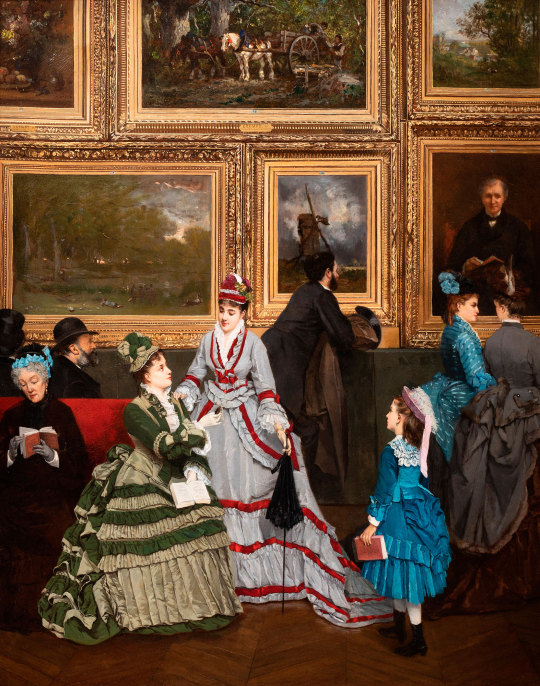
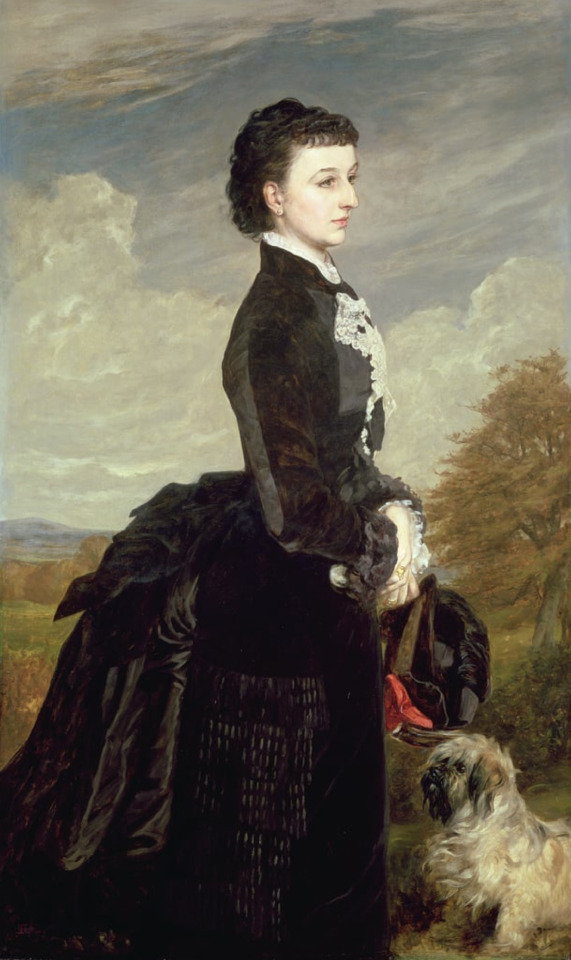
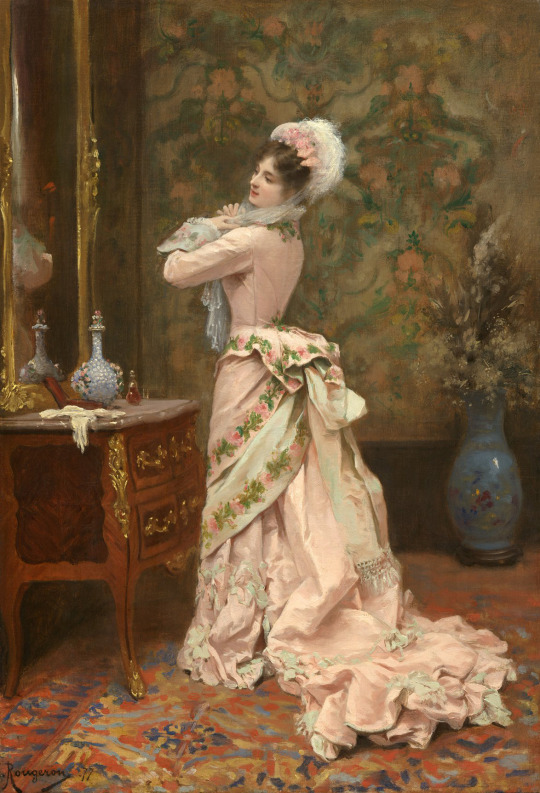

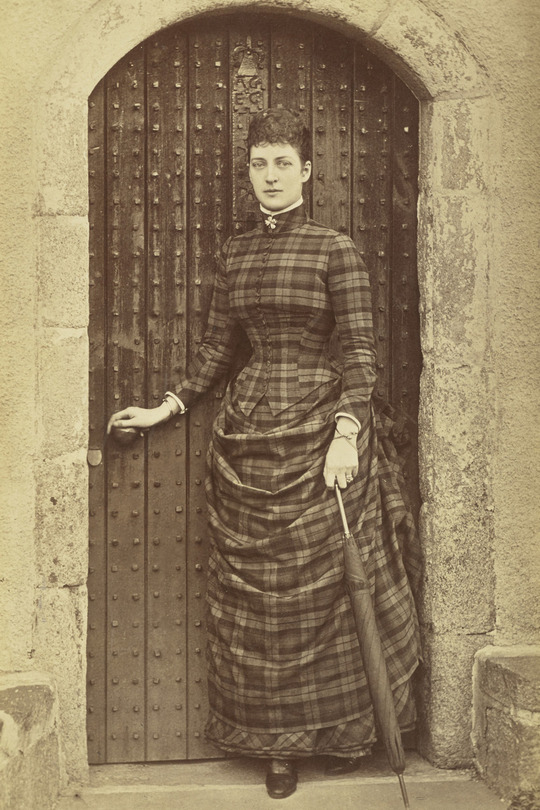
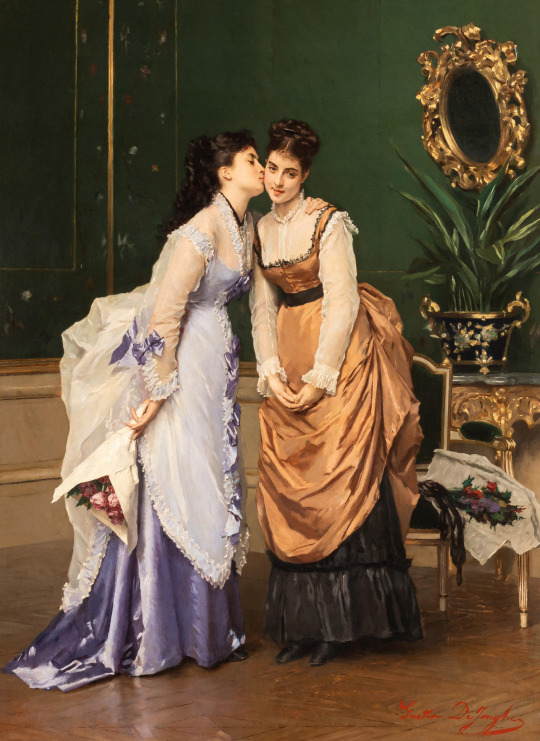

Middle and Late 1870s (from top to bottom) -
Le Salon de 1874 by Camille-Léopold Cabaillot-Lassalle (on sale at Ary Jean Art Gallery). From their Web site 1574X2000.
1875 Lady in Black with a Dog by James Archer (location ?). From meisterdrucke.de-kunstdrucke-James-Archer-197600-Porträt-einer-Dame-in-Schwarz-mit-einem-Hund,-1875 2308X3878.
1877 Toilette by Jules James Rougeron (Tokyo Fuji Art Museum - Tokyo, Japan). From facebook.com/MimiMatthewsAuthor/photos/toilette-by-jules-james-rougeron-1877-this-is-the-painting-thats-on-the-cover-of/2377279908990463/ 1174X1725.
Florentia Maria Crawshay 1849-1920), née Woods, as a Young Woman by ? (Cyfarthfa Castle Museum & Art Gallery - Merthyr Tydfil, Merthyr Tydfil, UK). From Wikimedia; fixed more obvious spots w Pshop 936X1200.jpg,
Princess of Wales Alexandra by W. & D. Downey (Royal Collection). From teatimeatwinterpalace.tumblr.com/post/167945509352/queen-alexandra-when-princess-of-wales-x 540X810.
Two elegant sisters in a luxurious interior by Gustave Léonard de Jonghe (location ?). From tumblr.com/artthatgivesmefeelings; fixed spots & some cracks w Pshop 2048X2809.
1879 Jacqueline Paton en robe noire by Léon Comerre (location ?). From tumblr.com/random-brushstrokes; fixed spots & flaws w Pshop 1627X3072.
#1870s fashion#late Victorian fashion#bustle period fashion#Camille-Léopold Cabaillot-Lassalle#hat#curly hair#blouse#jacket#bustle#flounces#stripes#James Archer#long sleeves#Jules James Rougeron#tablier#Florentia Maria Crawshay#bateau neckline#cap sleeves#fur boa#Queen Alexandra#W. & D. Downey#clerical neckline#plaid#Gustave Léonard de Jonghe#square neckline#yoke neckline#Jacqueline Paton#Léon Comerre
115 notes
·
View notes
Note
do you have some good sources about how women during the frev thought about universal male suffrage?
(i've been uncomfortable with some claims about how the frev was not feminist enough because women got the rights to vote in the 20th century, but cannot back up this discomfort.)
"I am quite limited on certain subjects and this is one of them (I am currently researching the exact thoughts of women during the French Revolution on universal suffrage).
Unfortunately, it has been a great shame that the French Revolution was misogynistic despite the meager rights that were gradually taken away from them over time. Even the greatest progressives like Sylvain Maréchal, who was an important disciple of Babeuf, had as a project to ensure that women did not have a say in the learning of reading.
The fact that misogyny was already present during the Ancien Régime (Marie Antoinette is blamed for all evils when in reality she did not have much say during her husband's reign, to better absolve Louis XVI and the policy of France under this absolute regime) or that Napoleon made the condition of women worse than that of Italy or Spain (I mentioned this in my post 'Women's Rights Suppressed') while being a great hypocrite does not absolve the revolutionaries for what they did in their misogyny.
There was a habit of attacking the wives of their adversaries to better discredit them (like Manon Roland, Marie Françoise Goupil, wife of Hébert, Lucile Duplessis, wife of Desmoulins), which is an interesting parallel on this point with the attacks against Marie Antoinette.
Olympe de Gouges spoke about the rights of women and citizens. Pauline Léon, Claire Lacombe, who demanded the right to organize in the national army. Théroigne de Méricourt, Louis Reine Audu, and again Claire Lacombe fought in the Tuileries and yet, despite being rewarded with a civic crown, they would not have the right to speak on universal suffrage.
Chaumette was a great misogynist, Robespierre too (one could tell me that he supported Louise de Keralio's candidacy for her entry into the academy, but in political matters, it was another story), Danton, Sylvain Maréchal, Amar, etc. I am not here to blame Robespierre and I deplore that there is a black legend about him, but one can see a certain purely political gesture in my opinion for the action he will take towards Simone Evrard.
As much as Simone Evrard is a very intelligent woman, with an extraordinary destiny very underestimated, capable of making very good political speeches (one of the people of the French Revolution that I admire the most), I wonder if the fact that Robespierre personally introduced her into the Assembly was just an opportunistic gesture because he would have had an additional reason to discredit Jacques Roux and Théophile Leclerc thanks to the speech she made while he was among the revolutionaries who approved the restriction of women's rights. Respect towards Simone Evrard regarding her dignity and intelligence (maybe even surely) opportunism, I would be tempted to answer on this by affirmative.
Risking repeating myself, Napoleon being a greater oppressor towards women by taking away the few rights they had, enacting oppressive and hypocritical laws, and even bloody ones concerning them, does not absolve the other revolutionaries of their sexism.
And there is no excuse that it was of their time (in fact, I noticed that this lie is used in my opinion to absolve Napoleon but not the revolutionaries, but forced to see that it fits into the same idea)... First of all, Charles Gilbert Romme was more progressive in women's rights, Marat and Charlier too, Camille Desmoulins thought that women could have the right to vote, Condorcet demanded gender equality, Guyomar opposed the exclusion of women from universal suffrage. Worse than anything, while the clubs and societies of women ended up being banned, which is a regression.
In 1795, for attempting to revolt against the Assembly which abolished the social policies of the Montagnards, they were prohibited from attending assemblies and even from gathering in the streets in groups of more than 5. Moreover, the term 'tricoteuse' to insult women was not invented during the Napoleonic era or the royalist era but in 1795.
What did women think about this? This is where I am quite limited because besides the answers I have given about these women and their actions, unfortunately, there is not much else I can say due to my limited knowledge.
In any case, I hope I have helped a bit to support the aforementioned statements.
In the meantime, I can provide some of my sources: the historian Mathilde Larrère, Antoine Resche who made very good summarized portraits of some revolutionary women on the website 'veni vidi sensi', I would also recommend reading the book by the writer Claude Guillon on Robespierre, women, and the Revolution (even though I completely disagree with some of his books that have been legally condemned, this one is rather good and he had a quite good blog on the French Revolution that I recommend checking out), and the historian Jean-Clément Martin, 'La révolte brisée'."
14 notes
·
View notes
Text

« Au début de l’année 1934, éclatait encore une fois un gros scandale financier de la Troisième République, l’escroquerie des Crédits municipaux, ayant, comme par hasard, pour principal auteur un Juif russe naturalisé, Stavisky. La complicité dans cette filouterie d’une justice putréfiée – ses personnages n’ont point changé – de la plupart des politiciens radicaux et maçons, n’avait jamais été plus flagrante. La presse et les organisations de droite s’en emparèrent, firent une campagne énorme. L’opinion suivit. Camille Chautemps, président du Conseil, le plus lourdement compromis parmi les protecteurs avérés du coquin juif, dut se démettre le 27 janvier. Son remplaçant, Daladier, apparut dès ses premiers actes comme le radical réputé "dur", chargé de sauver le parti et ses loges. Les manifestations de rues conduites par les troupes d’Action française se multipliaient et s’amplifiaient de jour en jour au chant du Ça ira.
L’extrême-gauche communiste amorçait une campagne parallèle. Le limogeage du préfet de police Chiappe, d’un arbitraire grossier, acheva de mettre le feu aux poudres. Le 6 février au soir, le rassemblement de plusieurs centaines de milliers de Parisiens, sur la place de la Concorde, prit rapidement l’aspect d’une insurrection populaire, ayant pour but immédiat l’Assemblée du Palais Bourbon. La police, fidèle en majorité au préfet éconduit réagissait mollement. La garde mobile créée par un ministère de droite contre les "rouges", défendait le pont. Le premier barrage fut forcé. La garde tira. Le premier mort tomba vers sept heures et demie. La manifestation, plus ou moins disloquée, devenue sporadique et qui, jusque-là, avait compris de nombreux curieux, se regroupa beaucoup plus serrée, et redoubla de violence à partir de dix heures. Les assauts des Parisiens, les fusillades de la garde se prolongèrent jusqu’à plus de minuit. La journée s’acheva avec le dernier métro…
La vieille République maçonnique demeurait maîtresse du terrain. Daladier, pourtant, était démissionnaire quelques heures plus tard. Paris vécut la journée du 7 pratiquement sans État, sous le contrôle des pelotons de la garde, dont on ne savait plus à qui ils obéissaient. Le soir, enfin, on apprenait l’arrivée au pouvoir d’un "conciliateur", Doumergue, dit par Léon Daudet "Gastounet le Brandadair". La démocratie était définitivement sauvée. Les vingt patriotes militants tombés dans la nuit du Six Février – exceptions les quelques curieux tués en dehors de la bagarre – ont leurs noms inscrits en tête du livre d’or de notre Révolution. (…)
Rien ne fut plus abject que la contre-offensive des Juifs, des Maçons, de la Ligue des Droits de l’Homme, des démocrates-chrétiens, de tous les humanitaires professionnels, tombant en transes pour l’exécution de quelque terroriste chinois, pour une touffe de cheveux arrachée dans le ghetto, et n’ayant que sarcasmes et rictus joviaux devant les morts français, les morts naïfs et purs de la Concorde. Jamais le bourreau ne fut plus cyniquement érigé en victime, et martyr désarmé mué en égorgeur. (…)
Nous avons longtemps traité avec beaucoup trop de pudeur et de réserve l’un des aspects pourtant essentiels de 1934. Nous avons porté rituellement de pieuses gerbes sur les tombes de nos camarades morts. Nous avons qualifié comme il convenait – nul ne l’a fait avec plus de puissance qu’Henri Béraud – les infectes et stupides canailles parlementaires qui les firent massacrer. Nous n’avons pas assez dit que nos morts furent aussi les victimes de leurs chefs. (…)
Le Six Février 1934, les chefs nationaux n’étaient pas sur la Concorde. J’y étais, aux minutes les plus meurtrières. Je ne les y ai pas vus, personne ne les y a vus. Ils étaient donc dans leurs postes de commandement. Ce pouvait être leur place. Je les y ai vus aussi, entre deux fusillades. Ils s’y tournaient les pouces, il s’y faisaient des mots d’esprit, ils se refusaient à croire qu’il y eût tant de morts que ça ! Ils n’avaient pas une consigne à distribuer, pas une idée en tête, pas un but devant eux. Les uns et les autres étaient moralement les obligés de la démocratie. Hors d’elle, ils n’avaient aucune raison d’exister. Sur ses tréteaux, ils assumaient le rôle obligatoire de l’opposant. Sautant sur une occasion assez considérable en effet, mécontents aussi du limogeage d’un policier indulgent à leurs frasques, ils venaient de se livrer au jeu classique de l’émeute, en forme de menace tartarinesque : "Retenez-moi ou je vais faire un malheur."
Mais pour ce petit jeu-là, ils avaient mobilisé des dizaines de milliers de jeunes hommes, de croyants ingénus, d’anciens soldats. Ils les avaient excités, fanatisés, chauffés à blanc. Au moment de l’action, la foule réapprit les gestes du combat et de la barricade, avec des morceaux de plâtre, des poignées de gravier et quelques lames Gillette fichées au bout d’un bâton. Les chefs, qui les avaient jetés poings nus contre les armes automatiques, s’étaient volatilisés, les uns sans doute par calcul (je pense à l’abject La Rocque), les autres saisis peut-être de vagues et tardifs remords, n’ayant plus guère qu’un souci : nier la gravité de l’événement qu’ils avaient criminellement engendré. Cette nuit-là, j’entendis Maurras dans son auto, parmi les rues désertes, déclarer avec une expression de soulagement : "En somme, Paris est très calme !" Oui, mais c’était le calme d’une chambre mortuaire.
La suite de l’histoire ne fut pas moins déshonorante. Les "chefs" de la droite firent un concert de clameurs. Certes, les "fusilleurs" étaient ignobles. Mais que leur reprochaient les "chefs" des ligues ? Ils leur reprochaient d’avoir triché en faisant tirer. Admirable politique de ces vieillards ! Incomparable symbole de cette bourgeoisie dégénérée, qui, pour n’avoir jamais eu la virilité de prendre les armes librement, de mettre sur sa conscience quelques cadavres nécessaires, aura été le complice de ses hallucinantes et imbéciles hécatombes, après desquelles le Six Février n’est même plus un fait divers en deux lignes ! Il eût fallu, en somme, que la République laissât aimablement bafouer et reconduire à coups de canne ses gendarmes, déculotter ses députés, envahir, saccager et brûler son Parlement, le tout représentant du reste, en l’occurrence, le chef d’œuvre de l’acte gratuit. Les ministres du Six Février, inutile de le cacher, avaient le droit de tirer. C’était même un devoir. (…)
Les chefs communistes, autres tireurs de ficelles, mais ceux-là, fort avisés, avaient lancé leurs fidèles sur le pavé pour profiter à toutes fins utiles du hourvari. Mais la majorité de ses fidèles ne s’en doutait pas. Pour la première fois depuis fort longtemps, les étudiants de Paris et les prolétaires rouges, armée traditionnelle de nos révolutions, manifestaient côte à côte contre la même corruption, avec la même sincérité, au même cri : "À bas les voleurs !" Les chefs de droite n’y comprirent rien, ils n’avaient rien prévu, ils ne savaient rien voir. (…)
Le Six Février (...) engendra certainement le Front populaire, favorisa en tout cas singulièrement sa naissance, en faisant figure d’une provocation énorme, passant de loin l’idéal de ce que l’adversaire le plus machiavélique pouvait rêver dans le genre. (…) Le Six Février démontra que l’armée d’une révolution nationaliste existait en France, mais que son erreur principale avait été de ne point faire d’abord sa révolution contre de pseudo-chefs.
Cette armée n’a pas pu s’anéantir en deux lustres. Éparse, elle existe toujours. Mais le "fascisme" français à la mode de 1934 n’était pas viable parce qu’il conservait trop d’attaches avec la vieille bourgeoisie de droite. Cette bourgeoisie accumula, dans ces heures fiévreuses de la dernière insurrection du type romantique, c’est-à-dire anachronique, les preuves définitives de sa caducité, de son aboulie, de son incapacité politique, de sa désunion, de sa légèreté cocardière. »
Lucien Rebatet, Les crimes du 6 février 1934, Je suis partout, 4 février 1944
5 notes
·
View notes
Text

Steve Lacy guitar and a messy room
#me#aphrodite#toronto#model#box braids#rock#music#alternative#steve lacy#steve lacy x fender#fender#stratocaster#guitar#electric guitar#camille léon
15 notes
·
View notes
Photo

Henri Fantin-Latour - By the Table, group portrait of Poètes Maudits, depicting: Paul Verlaine, Arthur Rimbaud, Léon Valade, Ernest d'Hervilly and Camille Pelletan (seated); Pierre Elzéar, Emile Blémont, and Jean Aicard (standing), 1872.
36 notes
·
View notes
Text
Kim Possible Episode Tiers: The F-Tier
We're conflating in the D-tier because I don't find it useful to discern "kind of bad" against "utter failure" in a show that I enjoy.
I should also emphasize the point that this is a show I really really like and I don't want to knock anyone's favorite episodes. This is just the group that I, personally, am the least fond of.
That said, there's a range of reasons to be in this tier from complete forgettability to being very memorable episode that has some problems. It's worth it to note that I didn't find any of these episodes particularly funny, because good humor is enough to save any KP episode for me.
Royal Pain: I like Rob Paulson and he does some great work on KP as a whole. However, Wally is a really annoying character and watching Ron bail on Kim for him wasn't great.
The Full Monkey: I'd say this is the weakest of the Monkey Fist episodes. The plot of it is mainly to lead up to the "Ron thinks Chippy is Kim" bit.

And the Mole Rat Will Be CGI: I guess it makes sense that Jr's fame-obsession would lead to film production. I always feel like when a show decides to jump into an industry critique metanarrative, it's more for the benefit of the show's makers than the audience.
Adventures in Rufus Sitting: Does anyone actually enjoy escort missions?
Day of the Snowmen: It's about a meteorologist creating evil snowmen accidentally because she wanted more interesting weather to report on. It wasn't going to be a top-tier episode, even if it was full length.
Grande Size Me: There is one funny joke in this one and that's all the villains being concerned about Ron letting himself go. The rest is largely forgettable and the parts that I do remember are Ron being not great to Kim, which I've already stated are my least favorite plotlines.

The Fearless Ferret: This is a nod to Batman Beyond, and I do appreciate it. That show is legitimately my favorite iteration of the animated Batmans (Batmen? Bats Man?). This is still kind of an annoying episode in that it spends a strange bit of time doing some industry critique surrounding washed up actors.
Chasing Rufus: I struggle to remember most of what happens in this episode other than Ron constantly getting bumped to first class because his seat keeps breaking. It's a three-way trip, Ron. Offer one of those seats to your girlfriend.

Nursery Crimes: I honestly think that they started with the idea for Ron being turned into a baby and worked backwards.
Trading Faces: I'd call this one wasted potential. Camille Léon is KP's version of Clayface and her power is one that is rife with storytelling potential. So why on earth are we doing another Kim learns to appreciate her brothers plot?
I do need to draw attention to one of the sweeter moments . . .

Roachie: Stephen Root is a treasure. I really don't have anything else positive to say about this one.
Fashion Victim: Framing Kim does get into one of those "more interesting" transformation plots I was talking about, but embedding it in the fashion world is rather pedestrian. The problem is that Kim is never really in danger of being accused for Camille's crimes and Monique's initial accusation seems rather ridiculous for the level of trust she and Kim ought to have built up over the years.
3 notes
·
View notes
Text
Lecture Notes MON 27th NOV
Masterlist
BUY ME A COFFEE
Doing Art History: Painting 2
French Art in the 19th century was heavily focused on Establishment painting, which is painting through patronage and academic painting type. However, while that type of painting was typical at the time, Avant-Garde (favouring or introducing new and experimental ideas and methods.) was coming in and reshaping art.
Leon Bonnat is one of these older French artists upholding academic painting, he was the default portraitist, especially for well-known and important figures.

Léon Bonnat, Louis Pasteur and his Granddaughter Camille Vallery-Radot, 1886, oil on canvas, Musée Pasteur
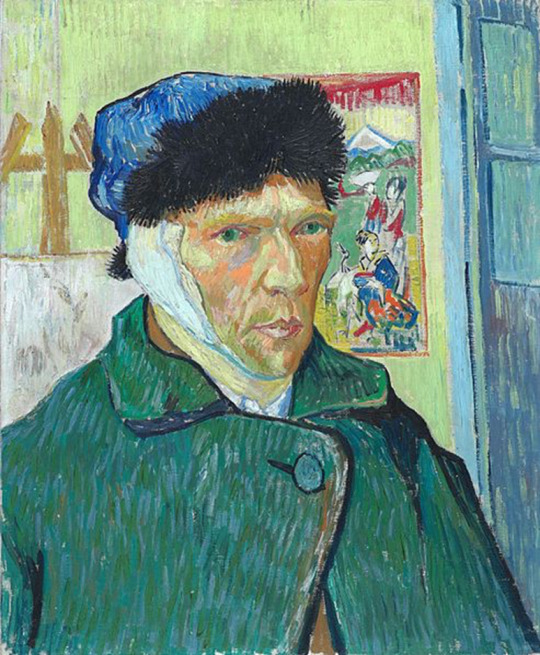
Vincent van Gogh, Self-Portrait with Bandaged Ear, 1889. Oil on canvas, 60.5 x 50 cm, Courtauld
Now look at Vincent Van Gogh and his self-portrait, made just three years later. Comparing the two artists, one is clearly far more Linear and the other Painterly. Bonnat was trained to paint in this style, the lack of eye contact from Pasteur gives him a thoughtful occupied academic look, while his granddaughters presence makes him appear as a family man. Moreover, she retains eye contact with the viewer, affirming the position of the viewer, bringing them in. While Van Gogh’s eye contact is far more subjective and debatable, to me he’s dissociating, looking far into the world, and lost to his mind. Ruminating if you will.
Which one do you refer? To what degree does an artist need to be trained/know painting to be good?
During this time historically there were new developments in colour and out understanding of the eye and retina: the prism, retinal imagery, etc.
Another Establishment artist: Alexandre Cabanel

Alexandre Cabanel, Birth of Venus, 1863, oil on canvas, 130 x 225 cm, Orsay
Consider the touch and tension, the fluidity of the painting.
Perhaps a feminist reading of the painting, as suggested by the lecturer was that to a 19t century audience, her nudeness and laid-back nature is one of relaxation. And while a 19th century lady would’ve had many layers of clothing, this nudeness would’ve appeared as freeing. However, there is something to say on a male artist telling a woman how to relax.
Although there is something to be said between nude bodies being depicted as opposed to a naked body. Nude: clothes in conversation of Western art, is depicted and painted as if the subject had never worn clothes and is idealised, by the skill of the painter. This painting is an example of that. Naked: is far less idealised, one that implies a body that has worn clothes before or even has some featured around somewhere in the painting. It might even appear dirty, and far more realistic.
Compared to Olympia, you can observe the difference between a nude and naked body.

Edouard Manet, Olympia, 1863, 130 x 190 cm, Orsay
The painting is linear, her gaze directed at the viewer, she’s sitting up in confrontation. A painting that’s non-allegorical, she is supposedly a prostitute, while unusual for nudes, she created quite a reaction from contemporary audiences. Critics considered her to have armpit hair even, with the way Manet painted her. They also criticised her femininity, as long flowing hair was a far more associated trait with femineity. Here she has hair bunched, and it almost disappears into the background, they claimed it made her look bald and dirty. This is very clearly a naked body as she has left over items of clothing on her, which imply the existence of clothes.
The person of colour featured in the painting is considered the attendant to the lady laying on the bed, as many brothels employed people of colour.
Orientalism:
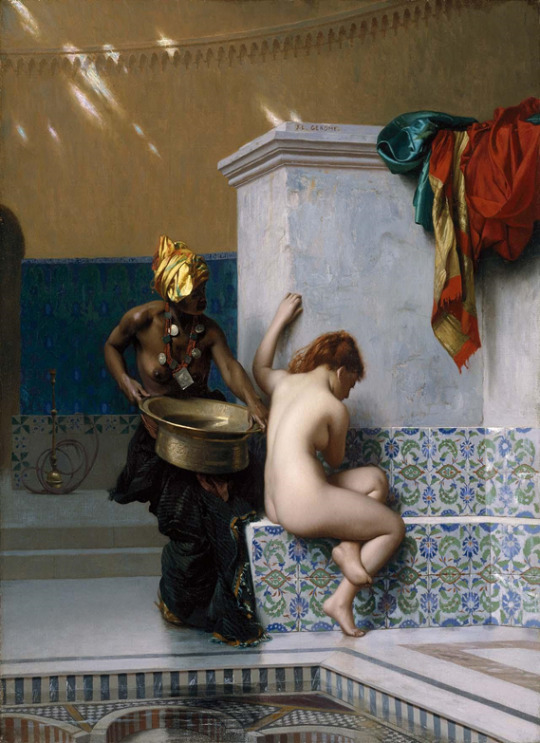
Jean-Léon Gérôme, Moorish Bath, 1870., Oil on canvas, 50 x 40 cm, The Museum of Fine Arts, Boston

Renoir, Odalisque, 1870. Oil on canvas, 69.2 x 122.6 cm , National Gallery Washington D.C.
Monet and Renoir were known to paint together, a good example of this are these two paintings of a boat house/boating place. They set up easels next to one another, creating similar but certainly different, emphatic paintings. Creating simple figures but different renderings, creating suggestions of figures. What is a finished work?
Sketch aesthetic: quick lines, shapes, casual blotting of colour, considered thoughtless. But focusing on mood and atmosphere more than anything. Created by the light, colour, weather – was always a race against the changing weather for the painters to capture.
This creates an individual experience for each viewer, applying and projecting personal experience onto the works, this was probably one of the great aspects and playing into impressionism. This temperament probably didn’t benefit the critics, but made art form a greater connection to that of the masses.
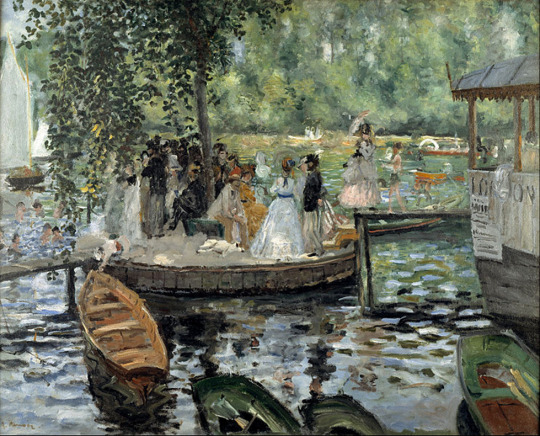

(Left) Pierre-Auguste Renoir, La Grenouillère, 1869, oil on canvas (Pushkin State Museum of Fine Arts, Moscow
(Right) Claude Monet, Bathers at La Grenouillère, 1869, oil on canvas, 73 x 92 cm (National Gallery, London)
Recommended further reading: The Painter of Modern Life, Charles Baudelaire, 1863 Part 1, 2, 3

Monet, Impression: Sunrise, 48 x 63 cm., Marmotton Paris

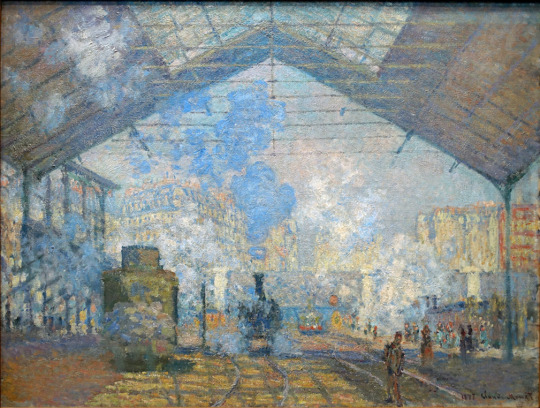
(Left) Monet, La Gare Saint-Lazare à l'Extérieur (Le Signal), 1877 , musée d'État de Basse-Saxe
(Right) Monet, The Gare Saint-Lazare (or Interior View of the Gare Saint-Lazare, the Auteuil Line), 1877, oil on canvas, 75 x 104 cm (Musée d’Orsay)
Completed as a series of studies of the La Gare Saint-Lazare, these paintings depict a modern life. Especially the one on the left, depicting perhaps an underside of modern life, through the choice of colour palette the painting evokes a dangerous atmosphere. And in some cases, lacks colour, depicting a fiery railway station and perhaps the underbelly a hellish side of the Industrial Revolution. The painting holds a certain thickness, with the figures reminiscent of the architecture, almost dehumanising the modern industry. Although, this thickness presents challenge, like the opacity of the piece, falling short in seeing and the lack of colour legibility. Monet manages to capture something visceral in the smoke.

Claude Monet, The Gare St. Lazare, 1877. Oil on canvas, 54.3 × 73.6 cm. The National Gallery of Art, London, Room 44
His style, while baring the characteristics of Impressionism also hold a certain pattern of texture, as he repeats the technique and repeats the textural pattern in his paintings. Not only in the smoke but in the landscape also.


(Left) Monet, Le matin au bord de la mer, 1881. Oil on canvas, 61 x 81 cm, Private Collection
(Right) Monet, Falaises des petites dalles, 1880. Oil on canvas. 59 x 75 cm, Museum of Fine Arts, Boston
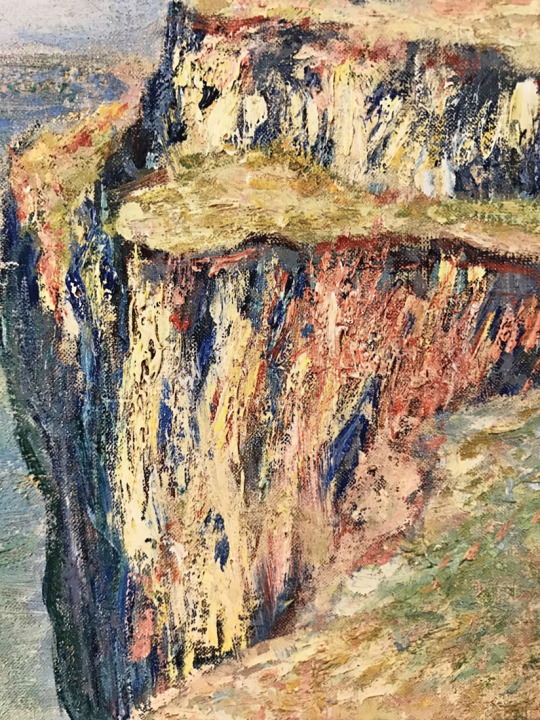

Claude Monet, La Falaise à Varengeville, 1882. Oil on canvas. 64.8 x 81.3 cm. Private Collection, USA
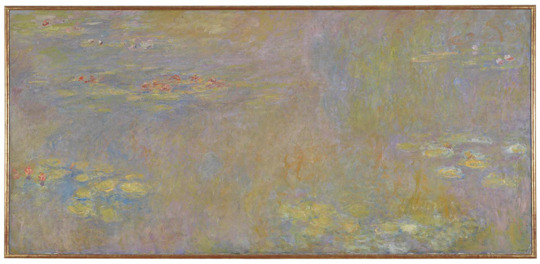
Claude Monet, Water-Lilies, after 1916. Oil on canvas, 200.7 × 426.7 cm. The National Gallery of Art, London, Room 41
1916 post-war Water Lillies were created by Monet as a symbol for peace and his response to WW1.
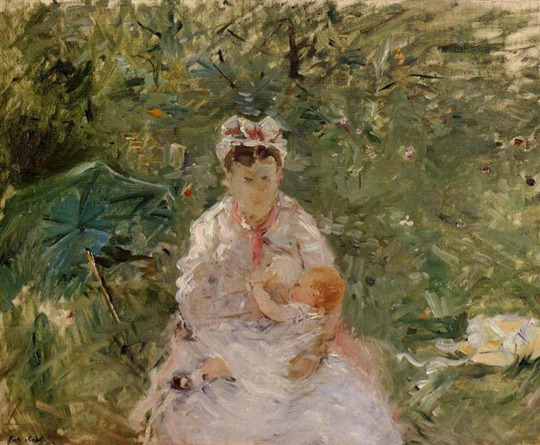
Berthe Morisot, The Wet Nurse and Julie, 1879 , 50 x 61 cm. Private Collection
Morisot was an upper-class woman, and to me this painting is a radical one. This is her wet nurse, feeding Morisot’s daughter, who is painting them. An example of a modern woman, critics didn’t wish to comment on her pieces due to liking her and believed Impressionism to be an art for women. Due to its atmospheric importance, and emotion behind it.

Georges Seurat, Bathers at Asnieres, 1884, National Gallery, 201 x 300 cm

Seurat, A Sunday on the grand Jatte, 1884. 207 x 308 cm., Art Institute of Chicago
Seurat was considered more of a post-impressionist (or neo impressionist), in the sense that he just came after the impressionists did. During this time pointillism was becoming a trend within art, due to the sciences attempting to link the arts into a more “disciplined art”. This art was considered mechanical and scientific in its creation, with the single dots that made up and blending at a distance. Although this creates a linear painting, making it static and like the bodies are mannequins.
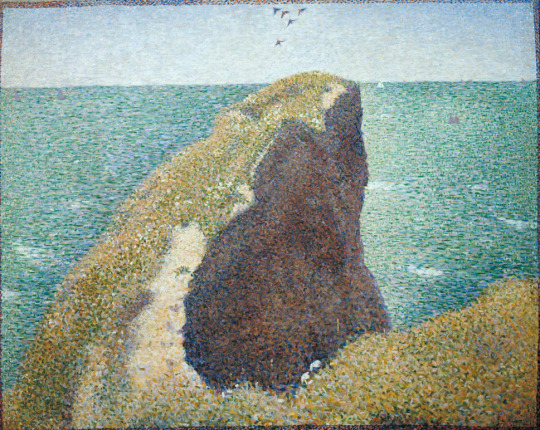
Paul Seurat. Le Bec du Hoc, Grandcamp, 1885. 64.8 × 81.6 cm. The National Gallery of Art, London, Room 43

Paul Gauguin, Spirit of the Dead Watching, 1892, oil on burlap mounted on canvas, 116.05 x 134.62 x 13.34 cm (Albright-Knox Art Gallery, Buffalo, NY)
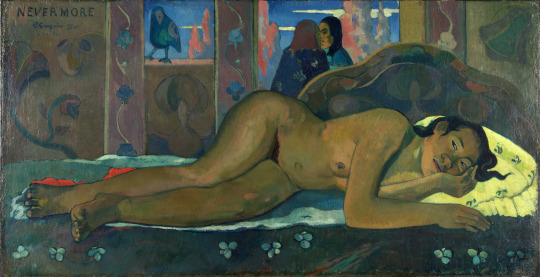
Paul Gauguin (1848-1903), Nevermore, 1897, The Samuel Courtauld Trust, The Courtauld Gallery, London
Gaugin’s Nevermore, was created by Gaugin when he was visiting certain islands, expecting to find an untouched paradise. When he arrived to find a colonised land that was not that primitive, there he used women to establish a place for himself and used the relationships with them to survive. These paintings in fact, are an example of that. His critics claimed his art appeared primitive, the opposite of civilised in this case, with the flat colours and basic shapes, although going against the common nude depictions.
#artwork#art tag#essay#paintings#art exhibition#art show#writing#art hitory#art#art gallery#artists#architecture#art history#impressionism#writers#watercolor#words#creative writing#in this essay i will#essay writing#personal essay#painting#writers on tumblr#history#illustration#drawings#lecture#historical#writeblr#writers and poets
0 notes
Text



Comme pour le daguerréotype, l’exiguïté du format laisse peu de place à l’anecdote, le nu apparaissant dans sa simplicité, entouré
d’un minimum d’accessoires. Toujours la même année, Louis-Camille d’Olivier dépose une soixantaine « d’études académiques » sur papier salé. Et plus encore l’année suivante. Les formats plus importants des tirages papiers, les études anatomiques et académiques parées de l’alibi artistique, laissent petit à petit la place à des images
plus élaborées, réalisées à partir de compositions empruntées, le plus souvent, aux mises en scène picturales et théâtrales. Ensuite, se retrouvent toutes les reconstitutions fantasmatiques qui vont envoûter la fin du XIXe siècle : l’Antiquité avec ses allégories mythologiques et l’orientalisme, exploités par des peintres conventionnels et emphatiques dits peintres pompiers, tels que Jean-Léon Gérôme ou des écrivains, comme Pierre Louÿs ou Félicien
Champsaur. En octobre 1860, la police perquisitionne chez le photographe Belloc au 16, rue de Lancry dans le Xe arrondissement de Paris. La femme Ducellier est surprise à sa table avec dix-neuf clichés pornographiques qu’elle est en train de colorier.


0 notes